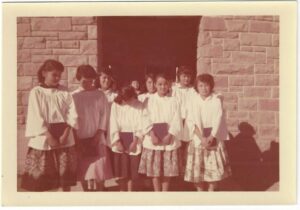 By Esther H. Moon
By Esther H. Moon
Navajoland! I was going to vacation on an Indian Reservation! At 21, I was going to visit my friend Ruth who just landed a job as a housemother for Good Shepherd Mission at Fort Defiance, Ariz. I took my first train ride to Gallup, N.M. The ticket was less than $40 round trip. It took me two days just to go one way. I arrived at Gallup at 7:15 a.m. on Sunday, August 15, 1959. From Gallup, it was a 32-mile drive to Fort Defiance.
When I arrived at the mission, I was blown away by the budding structures of the Episcopal church and their service to the Navajo children. Also visiting and learning about the work of the church amongst the Navajos were about a half a dozen college students from all around our nation. They were Episcopal Young Women on a summer church experience. They were not far off in age from becoming Episcopal Church Women. They assisted the Navajo children who were students at the mission. The primary goal of the mission in regard to the children was education, along with feeding them decent meals and assimilating the youngsters into western ways and thinking. I remember eating lunch; the cook fixed chopped bologna and pickle relish sandwiches. The children were overjoyed with the lunch.
The chapel service at the Good Shepherd Mission was at 10 a.m. This was my first experience of a dual-language Episcopal service. English and Navajo were spoken in the service of Morning Prayer from the 1928 Prayer Book. Twenty years later the Book of Common Prayer was revised to have more inclusive language. Canticles were intoned in an almost chantlike song. The sermon was spoken twice, once in English and then in Navajo.
The next day my eyes were opened to a new environment and culture. In 1959, 85,000 Navajos were governed by a tribal council. There were 76 districts of Navajo on the reservation, and each district had a representative. The council meetings were in English and translated into Navajo. The Episcopal Church was involved by sitting in on the tribal council. The Navajo Council Center was located at Window Rock, Ariz. The Director of Indian Affairs was not sympathetic to the needs and plights of the Navajos. At that time, I did not know of any other religious organization being around and as supportive as the Episcopal Church. To better understand the life on the reservation, I was driven about 10 miles to an outlying area. There, out in the middle of a hot and sandy land, were numerous Hogans–the homes of the Navajo. They were gathered into groups or neighborhoods. We took for granted all the comforts of home, like running water, electricity and central heat, which the Navajo did not have. They were a poor but proud group of people.
During the time I was there, they were celebrating an Indian ceremonial at the fairgrounds in Gallup. There were numerous exhibits of Indian arts and crafts. To my delight, there was a parade through town with Indians dressed in their native garb, dancing down the street. I was most fascinated with their sand paintings on the ground, how each color and grain of sand was made into a unique drawing. The jewelry was handcrafted and intricate in design. The artistry and skills are passed down from one generation to the next. At the fairgrounds, even in 1959, there was a lecture presented about the Navajos and the strides they were making in their education.
Now 60 years later, the Episcopal Church is still an important part of life in Navajoland. Let us pray that Covid-19 is eradicated soon. We, as women of the Church, know that our prayerful and monetary support makes a difference. Let us give the Navajo more washing stations, update their medical care, and improve their standard of living. And above all, let us remind them that God is the Great Physician.
As the Episcopal Church Women grows in Fort Defiance at the Good Shepherd Mission, let us be the plow which pushes the workers forward in caring for families of Navajoland.
Dear Father in heaven, You are the Great Healer of all mankind. Please touch the little ones and the big ones, too. They struggle to rise above the ills which have come like a mighty sword to their land. Put Your strong arm in the way of any further ills. Speak to those who have the ability to shore up their fight against any and all disease. Let them see Your light as the beacon of hope and wellness. We pray, O Lord, in Thy precious and holy name. May You be the glory over their entire nation. Amen
Esther H. Moon – Retired, Communication chairperson of the Episcopal Church Women,
Diocese of Los Angeles, CA- Province VIII
Contact: Good Shepherd Mission
1 Kit Carson Dr., Fort Defiance, AZ, 86504
www.ecofnavajoland.org

